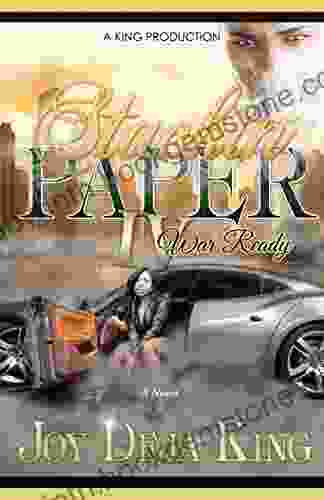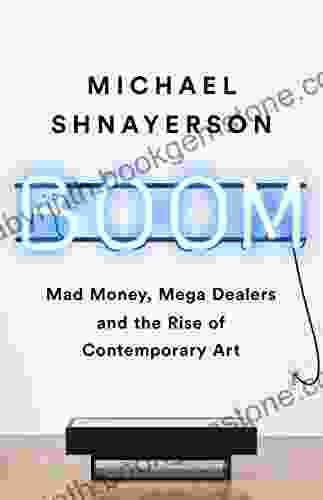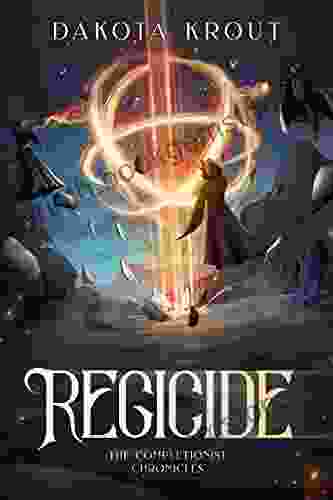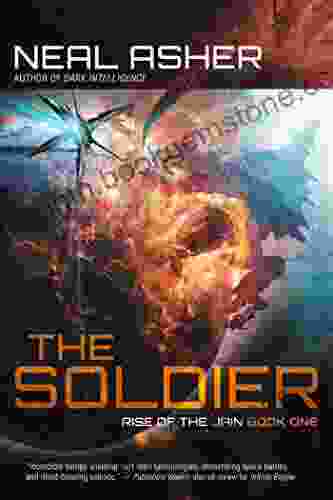Mad Money Mega Dealers and the Spectacular Rise of Contemporary Art

In the tumultuous world of high-stakes art collecting, a select group of dealers has emerged as the gatekeepers of contemporary art. These "mega-dealers", with their vast galleries and multi-million dollar budgets, have played a pivotal role in shaping the art market and propelling contemporary art to unprecedented heights.
Their influence extends far beyond the art world, as they have become tastemakers, trendsetters, and power brokers in the broader cultural landscape. This article delves into the rise of these mega-dealers, exploring their strategies, motivations, and the profound impact they have had on the art market and contemporary art.
4.5 out of 5
| Language | : | English |
| File size | : | 1739 KB |
| Text-to-Speech | : | Enabled |
| Screen Reader | : | Supported |
| Enhanced typesetting | : | Enabled |
| Word Wise | : | Enabled |
| Print length | : | 465 pages |
The Pioneers of Hypercapitalism in Art
The rise of mega-dealers can be traced back to the late 20th century, when a new generation of dealers emerged, breaking away from the traditional mold. Led by figures such as Larry Gagosian, David Zwirner, and Iwan Wirth, these dealers embraced the principles of hypercapitalism, transforming the art market into a high-stakes game of finance and speculation.
They established massive galleries in prime locations, showcasing works from established and emerging artists alike. They invested heavily in branding, marketing, and public relations, creating an aura of exclusivity and desirability around their galleries. And they leveraged their connections to wealthy collectors and institutions, establishing themselves as the go-to sources for acquiring the most sought-after artworks.
The Art of Money: Financialization and the Transformation of Art
One of the defining features of the mega-dealers' era is the financialization of art. Driven by the influx of capital from hedge funds, private equity, and other financial institutions, contemporary art became a highly speculative asset class. Dealers began to treat artworks as financial instruments, buying and selling them with the aim of maximizing returns.
This financialization had a profound impact on the art market. Prices soared to unprecedented levels, and the focus shifted from aesthetics to investibility. Artworks became status symbols and trophies, often divorced from their artistic merit. Dealers themselves amassed immense wealth, becoming multi-millionaires and even billionaires in some cases.
Curating the Canon: Shaping the Narrative of Contemporary Art
Mega-dealers have also played a significant role in shaping the narrative of contemporary art. Through their exhibitions, publications, and marketing campaigns, they have influenced the critical discourse around contemporary art, determining which artists gain recognition and which fall into obscurity.
By controlling access to major collectors and institutions, mega-dealers have the power to promote certain styles, movements, and artists over others. They have contributed to the rise of art stars, such as Jeff Koons, Damien Hirst, and Maurizio Cattelan, whose works have become synonymous with contemporary art.
Ethical Considerations and the Impact on Artists
The rise of mega-dealers has also raised ethical concerns. Critics argue that the hypercapitalization of art has led to a commodification of culture, where artistic integrity is sacrificed in favor of financial gain. The focus on speculation has created a distorted market, where prices are driven by hype and speculation rather than artistic value.
Furthermore, some artists have expressed frustration with the power imbalance between themselves and mega-dealers. They often find themselves at the mercy of the dealers, who control the distribution and sale of their work. This power dynamic can lead to exploitation and unfair treatment, as artists struggle to secure fair compensation and recognition for their contributions.
The rise of mega-dealers has been a transformative force in the world of art. They have played a crucial role in shaping the contemporary art market, influencing its financialization, curating its canon, and setting the trends that define the art world. While they have undoubtedly contributed to the increased visibility and popularity of contemporary art, concerns linger about the ethical implications of their hypercapitalist approach and its impact on artists.
As the art world continues to evolve, it remains to be seen how mega-dealers will adapt to changing market dynamics and shifting cultural values. One thing is certain: they will continue to wield significant influence in the art world, shaping its future course and the legacy of contemporary art.
Alt Text for Images
* **Image 1:** Larry Gagosian, one of the most powerful mega-dealers, standing in front of an artwork in his gallery. * **Image 2:** A crowded art fair, with visitors examining artworks displayed by mega-dealers. * **Image 3:** A contemporary artwork by Jeff Koons, a prominent artist represented by mega-dealers.
4.5 out of 5
| Language | : | English |
| File size | : | 1739 KB |
| Text-to-Speech | : | Enabled |
| Screen Reader | : | Supported |
| Enhanced typesetting | : | Enabled |
| Word Wise | : | Enabled |
| Print length | : | 465 pages |
Do you want to contribute by writing guest posts on this blog?
Please contact us and send us a resume of previous articles that you have written.
 Best Book
Best Book Page Flip
Page Flip Bookshelf
Bookshelf Literary loom
Literary loom Chapter
Chapter Bookish
Bookish PageTurner
PageTurner Bibliophile
Bibliophile Story
Story Inkwell
Inkwell Bookworm
Bookworm Labyrinth
Labyrinth Plot Twist
Plot Twist Prose
Prose Paperback
Paperback Storyteller
Storyteller Sanctuary
Sanctuary Fiction
Fiction Reading
Reading Chronicle
Chronicle Read
Read William Schoell
William Schoell Liza Rodman
Liza Rodman D K Pike
D K Pike Kati Marton
Kati Marton Eric Musgrave
Eric Musgrave Zeena Shah
Zeena Shah Robert E Innis
Robert E Innis Craig Martelle
Craig Martelle Joshua M Greene
Joshua M Greene Iris Apfel
Iris Apfel Loretta Outwater Cox
Loretta Outwater Cox Massimiliano Musina
Massimiliano Musina Joy Castro
Joy Castro Irene Aylworth Douglass
Irene Aylworth Douglass George Saunders
George Saunders Colleen Hall
Colleen Hall Jeanne Farr Mcdonnell
Jeanne Farr Mcdonnell Harold P Howard
Harold P Howard Michael Shnayerson
Michael Shnayerson Conn Iggulden
Conn Iggulden Sean Hartlieb
Sean Hartlieb Cyrus Highsmith
Cyrus Highsmith Craig Melvin
Craig Melvin Tracey Lange
Tracey Lange Frank Bruni
Frank Bruni Jeremy Kroeker
Jeremy Kroeker Janet Catherine Berlo
Janet Catherine Berlo Clifford Irving
Clifford Irving Eric Jerome Dickey
Eric Jerome Dickey Denise Hamilton
Denise Hamilton Jerry Brotton
Jerry Brotton Wyclef Jean
Wyclef Jean Kristina Mcmorris
Kristina Mcmorris Ketut Suasti
Ketut Suasti William J Burns
William J Burns Peter Parnell
Peter Parnell Mark Cramer
Mark Cramer Coryne Hall
Coryne Hall Mark Dawson
Mark Dawson Rayna Tyler
Rayna Tyler Mia Black
Mia Black Henry Koster
Henry Koster L A Braun
L A Braun Dahlma Llanos Figueroa
Dahlma Llanos Figueroa Craig W Stanfill
Craig W Stanfill Graham Wilson
Graham Wilson Gerry Virtue
Gerry Virtue Ellie Taylor
Ellie Taylor Hyeonseo Lee
Hyeonseo Lee Linda Riesenberg Fisler
Linda Riesenberg Fisler Kelly Gay
Kelly Gay David G Hartwell
David G Hartwell Yoko Hatta
Yoko Hatta Hannah Hart
Hannah Hart Eleanor Ford
Eleanor Ford Melissa Stephenson
Melissa Stephenson Scott Kenemore
Scott Kenemore Hal Vaughan
Hal Vaughan Eric Lax
Eric Lax Torre Deroche
Torre Deroche Sarah Thornton
Sarah Thornton Cory Doctorow
Cory Doctorow Dale Pollock
Dale Pollock Daniel Burleigh Parkhurst
Daniel Burleigh Parkhurst Crystal Allen
Crystal Allen Coert Voorhees
Coert Voorhees Jaclyn Bailie
Jaclyn Bailie Tinia Montford
Tinia Montford Cristy C Road
Cristy C Road Elizabeth Reid
Elizabeth Reid Cliff Mass
Cliff Mass Danny Trejo
Danny Trejo Kathryn Mcmaster
Kathryn Mcmaster Domnica Radulescu
Domnica Radulescu Explorer Publishing
Explorer Publishing Natasha Sims
Natasha Sims Alexa West
Alexa West Cookie Johnson
Cookie Johnson Carrie Stuart Parks
Carrie Stuart Parks Ella Barrick
Ella Barrick Roberto Pedreira
Roberto Pedreira Leonard S Marcus
Leonard S Marcus Cricut Maker
Cricut Maker Cynthia Newcomer Daniel
Cynthia Newcomer Daniel Dan Diggles
Dan Diggles W B Yeats
W B Yeats Monika Forsberg
Monika Forsberg Paula Giddings
Paula Giddings Euclides Da Cunha
Euclides Da Cunha Warren Murphy
Warren Murphy Crypto Dukedom
Crypto Dukedom D Ward Cornell
D Ward Cornell Michael Reardon
Michael Reardon Susan Cross
Susan Cross Michelle Brown
Michelle Brown Bob Martin
Bob Martin Lina Rather
Lina Rather Carlos M N Eire
Carlos M N Eire Donna Jackson Nakazawa
Donna Jackson Nakazawa Victor Villasenor
Victor Villasenor Xiaolu Guo
Xiaolu Guo Mitsuo Kure
Mitsuo Kure Grace Barrington Shaw
Grace Barrington Shaw Gianrico Carofiglio
Gianrico Carofiglio Michael Henry
Michael Henry Sarena Ulibarri
Sarena Ulibarri K C Jones
K C Jones Jeff Tanyard
Jeff Tanyard Yelapa Memo
Yelapa Memo Wade Motawi
Wade Motawi Terry Darlington
Terry Darlington Ronald G Knapp
Ronald G Knapp Mia Michaels
Mia Michaels R Allen Chappell
R Allen Chappell Ingrid Sischy
Ingrid Sischy Neal Stephenson
Neal Stephenson Steven Collins
Steven Collins Tracy Lambert
Tracy Lambert Todd Geers
Todd Geers Connie Willis
Connie Willis Lan Sluder
Lan Sluder Coryn Anaya Clarke
Coryn Anaya Clarke Jessica Walstad
Jessica Walstad Yair Lapid
Yair Lapid Max Allan Collins
Max Allan Collins Jennifer Thompson Cannino
Jennifer Thompson Cannino Cp Mchugh
Cp Mchugh Eat Like A Local
Eat Like A Local Culture Smart
Culture Smart Eva Heller
Eva Heller Colin Jones
Colin Jones Fred Ladd
Fred Ladd Theo Dorgan
Theo Dorgan Corky Parker
Corky Parker Colson Whitehead
Colson Whitehead Nigel Barley
Nigel Barley Isadora Duncan
Isadora Duncan Niall Teasdale
Niall Teasdale Beverly Jenkins
Beverly Jenkins Sue Tabashnik
Sue Tabashnik T R Napper
T R Napper Cynthia Clampitt
Cynthia Clampitt Andrew Patrick Nelson
Andrew Patrick Nelson John Tanner
John Tanner Ernst Bergen
Ernst Bergen Peter Hanson
Peter Hanson Craig Briggs
Craig Briggs John Logan
John Logan Cookie Mueller
Cookie Mueller Bill Geist
Bill Geist Maya Angelou
Maya Angelou Dk Eyewitness
Dk Eyewitness Irene Levin Berman
Irene Levin Berman Daniel Ankele
Daniel Ankele Dan Gheno
Dan Gheno J Robert Kennedy
J Robert Kennedy Joe Starita
Joe Starita Robert Appleton
Robert Appleton Steve Huston
Steve Huston Love Belvin
Love Belvin Dan Simmons
Dan Simmons Karl Johnson
Karl Johnson Cristina Salat
Cristina Salat Gina Mckinnon
Gina Mckinnon Parvati Sharma
Parvati Sharma Harry Lorayne
Harry Lorayne Lorraine Bartlett
Lorraine Bartlett Lisa Morton
Lisa Morton Peter Ninnes
Peter Ninnes Jeffrey Alford
Jeffrey Alford Ian Whitaker
Ian Whitaker Dani Dyer
Dani Dyer Douglas Century
Douglas Century Grady Hendrix
Grady Hendrix Scott Moon
Scott Moon Margaret Fletcher
Margaret Fletcher James Rosenquist
James Rosenquist Kate Moore
Kate Moore Marc Canter
Marc Canter Joshua T Calvert
Joshua T Calvert Darren Critchley
Darren Critchley Issa Rae
Issa Rae Robert Isenberg
Robert Isenberg Reprint Edition Kindle Edition
Reprint Edition Kindle Edition David Drake
David Drake Helen Armstrong
Helen Armstrong Les Standiford
Les Standiford Tony Rafael
Tony Rafael Faye Moskowitz
Faye Moskowitz Piera Sonnino
Piera Sonnino Dana Facaros
Dana Facaros Xinran
Xinran Diane Cardaci
Diane Cardaci Collins Dictionaries
Collins Dictionaries Craig Carey
Craig Carey Diana Hollingsworth Gessler
Diana Hollingsworth Gessler Roy Simmons
Roy Simmons Karolyn Kiisel
Karolyn Kiisel Cornelius Tacitus
Cornelius Tacitus Brad Olsen
Brad Olsen Julissa Arce
Julissa Arce Dan Grunfeld
Dan Grunfeld Thaddeus Carhart
Thaddeus Carhart Michelle L Hardy
Michelle L Hardy Rory Miller
Rory Miller Cornelius C Kubler
Cornelius C Kubler Ron Celano
Ron Celano T D Lake
T D Lake Craig Seymour
Craig Seymour David Kroese
David Kroese Mary Alice Monroe
Mary Alice Monroe Jennifer Brozek
Jennifer Brozek Donald Spoto
Donald Spoto Ben Ohmart
Ben Ohmart Dan Abnett
Dan Abnett Henry James
Henry James Irving Layton
Irving Layton T Scott Bryan
T Scott Bryan Dan Sugralinov
Dan Sugralinov Emma Larkin
Emma Larkin Meredith Little
Meredith Little Olan Thorensen
Olan Thorensen David Riley
David Riley Crispin Sartwell
Crispin Sartwell Pearl Tate
Pearl Tate Marie Killilea
Marie Killilea Gael Berton
Gael Berton Yuriko Saito
Yuriko Saito Terri Kozlowski
Terri Kozlowski Cornelius N Grove
Cornelius N Grove Jessica Kerwin Jenkins
Jessica Kerwin Jenkins Douglas Preston
Douglas Preston Richard K Morgan
Richard K Morgan Porochista Khakpour
Porochista Khakpour Fiona Ferris
Fiona Ferris Matthew Quirk
Matthew Quirk D Dauphinee
D Dauphinee Lorne Ryburn
Lorne Ryburn Tom Poland
Tom Poland Marko Kloos
Marko Kloos Clive Johnson
Clive Johnson Tom Satterly
Tom Satterly Taylor Fuller
Taylor Fuller Yunte Huang
Yunte Huang Diana Friel Mcgowin
Diana Friel Mcgowin Danielle Krysa
Danielle Krysa Dale Robinson
Dale Robinson Robert Silverberg
Robert Silverberg Rebecca Hardiman
Rebecca Hardiman Marcus Richardson
Marcus Richardson D J Bodden
D J Bodden Nick Snelling
Nick Snelling Chris Strodder
Chris Strodder Dan Popp
Dan Popp Frances Dinkelspiel
Frances Dinkelspiel Jay Ryan
Jay Ryan Tc Manning
Tc Manning Kevin J Anderson
Kevin J Anderson Barrington Barber
Barrington Barber Dana Sachs
Dana Sachs Dalai Lama
Dalai Lama D K Holmberg
D K Holmberg Jim Hutchinson
Jim Hutchinson Luca Turin
Luca Turin Mancho Soto
Mancho Soto R P Jones
R P Jones Serena Gilbert
Serena Gilbert Sarah Jackson
Sarah Jackson Jennifer M Eaton
Jennifer M Eaton Helen Augur
Helen Augur Sara Ackerman
Sara Ackerman Sean Williams
Sean Williams Cynthia Saltzman
Cynthia Saltzman David Cousens
David Cousens Twyla Tharp
Twyla Tharp Dan Zehr
Dan Zehr Clayton Thomas Muller
Clayton Thomas Muller Janet Koplos
Janet Koplos Amaya Black
Amaya Black Insun Lee
Insun Lee Joy Deja King
Joy Deja King Julie Lythcott Haims
Julie Lythcott Haims Marya Hornbacher
Marya Hornbacher Dennis Valder
Dennis Valder Kirstin Dow
Kirstin Dow Garry Mcgee
Garry Mcgee Brandon Q Morris
Brandon Q Morris Dr Quinta
Dr Quinta Gene Wolfe
Gene Wolfe Jason Cochran
Jason Cochran Julia Chiles
Julia Chiles Sasha Duerr
Sasha Duerr Nancy Marchant
Nancy Marchant Siri Hustvedt
Siri Hustvedt Virginia Matheson Hooker
Virginia Matheson Hooker Craig Johnson
Craig Johnson Susan Yeates
Susan Yeates Thefirstdefier
Thefirstdefier Jon May
Jon May Dennis Lehane
Dennis Lehane Ward Larsen
Ward Larsen Fiona Davis
Fiona Davis G B Edwards
G B Edwards Craig Ferguson
Craig Ferguson David W Galenson
David W Galenson Dallas Shaw
Dallas Shaw Dawn Turner Trice
Dawn Turner Trice Leah Gallo
Leah Gallo James Alan Gardner
James Alan Gardner Craig Mod
Craig Mod John Baxter
John Baxter Lisa Yaszek
Lisa Yaszek Mary Paik Lee
Mary Paik Lee James Seabright
James Seabright Maggie Rowe
Maggie Rowe Baby Professor
Baby Professor Sarah Culberson
Sarah Culberson Mike Katz
Mike Katz Jeromy Hopgood
Jeromy Hopgood Em Brown
Em Brown Isabella Maldonado
Isabella Maldonado Maham Johnson
Maham Johnson Ian Douglas
Ian Douglas Yutaka Yazawa
Yutaka Yazawa Marc Taro Holmes
Marc Taro Holmes Nick Jans
Nick Jans John Luther Adams
John Luther Adams Craig A Falconer
Craig A Falconer John Parascandola
John Parascandola Keith Recker
Keith Recker David E Wilkins
David E Wilkins David Maraniss
David Maraniss Mary Boone
Mary Boone Hayley Stone
Hayley Stone Jodi Picoult
Jodi Picoult Steve Biddle
Steve Biddle Nancey Cummings
Nancey Cummings P A Piatt
P A Piatt Khadizhat Witt
Khadizhat Witt Jacques D Amboise
Jacques D Amboise Karen Stocker
Karen Stocker Stephen Armstrong
Stephen Armstrong Damion Hunter
Damion Hunter Eddie Robson
Eddie Robson Kristen Britain
Kristen Britain Sue Monk Kidd
Sue Monk Kidd Norman Hathaway
Norman Hathaway Saad Z Hossain
Saad Z Hossain Jake Spicer
Jake Spicer Ursula K Le Guin
Ursula K Le Guin Colin Thubron
Colin Thubron L E Modesitt Jr
L E Modesitt Jr Daigo Murasaki
Daigo Murasaki Karen Cheung
Karen Cheung Margaret Coker
Margaret Coker Tom Hill
Tom Hill J Z Foster
J Z Foster Ann Fessler
Ann Fessler Deanna Amodeo
Deanna Amodeo Dave Willmarth
Dave Willmarth Hannah Strong
Hannah Strong Michelle Damiani
Michelle Damiani Clementina Oluchi Augustine
Clementina Oluchi Augustine Kristina Evans
Kristina Evans John Grisham
John Grisham Connie Mcbride
Connie Mcbride Robert De La Sizeranne
Robert De La Sizeranne Blair Polly
Blair Polly True Kelley
True Kelley Lee Feigon
Lee Feigon Jeremy Robert Johnson
Jeremy Robert Johnson Co Spinhoven
Co Spinhoven S A Snyder
S A Snyder Mark Bourrie
Mark Bourrie Jason M Hough
Jason M Hough Megan Lynch
Megan Lynch Yuri Ulengov
Yuri Ulengov Laura Donnelly Bethmann
Laura Donnelly Bethmann Sam Branson
Sam Branson Marius Kociejowski
Marius Kociejowski Cynthia Leal Massey
Cynthia Leal Massey Myriam Gurba
Myriam Gurba Daniel L Bray
Daniel L Bray Karen Swan
Karen Swan J J Green
J J Green John Dennehy
John Dennehy Lin Wellford
Lin Wellford Philip Simmons
Philip Simmons Rami Yelda
Rami Yelda Dale Brown
Dale Brown Olivia Dade
Olivia Dade Leila Guerriero
Leila Guerriero James Patterson
James Patterson Dan Fox
Dan Fox Joan Didion
Joan Didion Cyril W Beaumont
Cyril W Beaumont Clyde D Souza
Clyde D Souza Ted Andrews
Ted Andrews Jon Breakfield
Jon Breakfield Connie Malamed
Connie Malamed Sean Egan
Sean Egan Jordan Matter
Jordan Matter Nathan D Horowitz
Nathan D Horowitz June Emerson
June Emerson Edward Johnston
Edward Johnston Leslie Cabarga
Leslie Cabarga Pat Grillo
Pat Grillo Joan D Vinge
Joan D Vinge Henning Nelms
Henning Nelms D Scott Bowers
D Scott Bowers Cody Whitfill
Cody Whitfill Lisanne Norman
Lisanne Norman Gerald Everett Jones
Gerald Everett Jones John Mcwade
John Mcwade James Rubik
James Rubik David Walton
David Walton Cynthia Royce
Cynthia Royce Trenae
Trenae Harvey J Kaye
Harvey J Kaye Richard East
Richard East Kenya Clark
Kenya Clark Colin Souness
Colin Souness Cora Tesheira
Cora Tesheira Susan Hayes
Susan Hayes Jay C Labarge
Jay C Labarge Dallen J Timothy
Dallen J Timothy Clive Cussler
Clive Cussler Jeremy Ford
Jeremy Ford Tim Judah
Tim Judah T J Clark
T J Clark Laurent Dubois
Laurent Dubois Susan Linden Emde
Susan Linden Emde Marie Brennan
Marie Brennan Ronald Pratt
Ronald Pratt Luis Alberto Urrea
Luis Alberto Urrea Elizabeth May
Elizabeth May Sujean Rim
Sujean Rim Steven Skaggs
Steven Skaggs Synithia Williams
Synithia Williams Courtney Ragsdale
Courtney Ragsdale Nelson Demille
Nelson Demille Karen Mcnally
Karen Mcnally Ernest J Gaines
Ernest J Gaines William Evans
William Evans Coralie Bickford Smith
Coralie Bickford Smith Stephen Kinzer
Stephen Kinzer Gabrielle Zevin
Gabrielle Zevin Pat Kramer
Pat Kramer Stephen Brooks
Stephen Brooks D J Holmes
D J Holmes Gina Yashere
Gina Yashere Prince
Prince J C Romero
J C Romero Grace Goodwin
Grace Goodwin Tim Vernooij
Tim Vernooij Gabrielle Selz
Gabrielle Selz Gerda Weissmann Klein
Gerda Weissmann Klein Fethi Mansouri
Fethi Mansouri Dick J Reavis
Dick J Reavis David Bischoff
David Bischoff Curatoria Draconis
Curatoria Draconis Roy Kinnard
Roy Kinnard Thrive Language Audiobooks
Thrive Language Audiobooks Jane Sutcliffe
Jane Sutcliffe Carl Sagan
Carl Sagan Sheila Montilla
Sheila Montilla David Mikics
David Mikics Sandee Cohen
Sandee Cohen Eric Trueheart
Eric Trueheart William Powers
William Powers Dan X Solo
Dan X Solo Daily Language Learning
Daily Language Learning Ian Frazier
Ian Frazier Tony Pike
Tony Pike V D Bucket
V D Bucket Nicolas Lampert
Nicolas Lampert Minal Hajratwala
Minal Hajratwala C F Jernigan
C F Jernigan J A Johnstone
J A Johnstone Dakota Krout
Dakota Krout Donna Zakowska
Donna Zakowska Geoff Saunders
Geoff Saunders Olivia Campbell
Olivia Campbell John Paul Brammer
John Paul Brammer Daniel Abraham
Daniel Abraham Nick Lyons
Nick Lyons Steve Reifenberg
Steve Reifenberg Jerry Beck
Jerry Beck Marisol Enchufa
Marisol Enchufa Jane Hamilton
Jane Hamilton Karen O Brien
Karen O Brien Tana Stone
Tana Stone Kyle Widner
Kyle Widner Cristela Alonzo
Cristela Alonzo Sara Wheeler
Sara Wheeler Cyn Alexander
Cyn Alexander Criss Angel
Criss Angel Nawoko
Nawoko T J S George
T J S George M R Forbes
M R Forbes S M Anderson
S M Anderson Dan Bigley
Dan Bigley Tom Geng
Tom Geng Dakota James
Dakota James Danica Roem
Danica Roem Pierre Alex Jeanty
Pierre Alex Jeanty Deborah Davis
Deborah Davis John Humphries
John Humphries
Light bulbAdvertise smarter! Our strategic ad space ensures maximum exposure. Reserve your spot today!

 Jeffery BellReturn to Haven: Empire Rising - A Literary Exploration of Hope, Redemption,...
Jeffery BellReturn to Haven: Empire Rising - A Literary Exploration of Hope, Redemption,... Jack LondonFollow ·19.1k
Jack LondonFollow ·19.1k Kirk HayesFollow ·7.5k
Kirk HayesFollow ·7.5k Angelo WardFollow ·17.6k
Angelo WardFollow ·17.6k Hugo CoxFollow ·4.5k
Hugo CoxFollow ·4.5k Kenneth ParkerFollow ·16.7k
Kenneth ParkerFollow ·16.7k Aubrey BlairFollow ·10.5k
Aubrey BlairFollow ·10.5k Andy HayesFollow ·8.4k
Andy HayesFollow ·8.4k Dave SimmonsFollow ·9.1k
Dave SimmonsFollow ·9.1k

 Billy Peterson
Billy PetersonStackin' Paper Part War Ready: A Comprehensive Guide to...
In today's competitive financial landscape,...

 Jedidiah Hayes
Jedidiah HayesDennis Valder: Unveiling the Enchanting World of Cuba's...
In the heart...

 Ryan Foster
Ryan FosterDelving into the Captivating Enigma of The Green Season...
In the verdant tapestry of literary...

 Jeremy Mitchell
Jeremy MitchellZapotec Helen Augur: A Visionary Leader and Cultural...
In the heart of...

 Larry Reed
Larry ReedSci-Fi Alien Warrior Romance: A Tribute to the Brides of...
In the vast expanse of the...
4.5 out of 5
| Language | : | English |
| File size | : | 1739 KB |
| Text-to-Speech | : | Enabled |
| Screen Reader | : | Supported |
| Enhanced typesetting | : | Enabled |
| Word Wise | : | Enabled |
| Print length | : | 465 pages |












